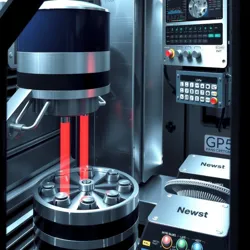Adaptive Machining Systems
Adaptive machining systems are advanced industrial technologies designed to enhance the precision, efficiency, and flexibility of machining processes. These systems integrate real-time feedback mechanisms, allowing machines to adjust cutting parameters dynamically during operations. This adaptability is particularly beneficial in sectors requiring high customization and precision, such as aerospace and medical device manufacturing.
Overview
Adaptive machining systems represent a significant leap from traditional machining methods. Unlike conventional systems, which rely on pre-set parameters, adaptive systems can modify their operations based on real-time data. This capability reduces the likelihood of errors, minimizes material waste, and extends the lifespan of cutting tools.
These systems often employ artificial intelligence in metal fabrication to analyze data from sensors and adjust operations accordingly. By doing so, they can maintain optimal cutting conditions even as tool wear progresses or material properties vary.
Key Components
Adaptive machining systems consist of several critical components:
-
Sensors: These devices collect real-time data on factors such as tool position, temperature, and vibration. High-precision sensors are crucial for detecting subtle changes that could affect machining accuracy.
-
Control Software: The software processes sensor data and determines the necessary adjustments to the machining process. This software is often powered by machine learning algorithms, enabling it to improve over time.
-
Actuators: These components execute the adjustments dictated by the control software, altering the machine's operations as needed to maintain precision and efficiency.
-
Feedback Loops: Integral to adaptive systems, feedback loops allow continuous communication between sensors, control software, and actuators, ensuring the system remains responsive to changes.
Applications
Adaptive machining systems find applications in various industries:
-
Aerospace: In the aerospace sector, where components must meet strict precision standards, adaptive systems ensure that parts like turbine blades and structural components are manufactured with minimal deviations.
-
Medical Devices: Adaptive machining is used to produce complex medical devices and implants that require high precision and customization.
-
Automotive: The automotive industry uses these systems to improve the quality and consistency of engine and transmission components, enhancing performance and reliability.
Advantages
The adoption of adaptive machining systems offers several advantages:
-
Increased Efficiency: By reducing the need for manual adjustments and decreasing downtime, these systems improve overall production efficiency.
-
Enhanced Precision: The ability to adjust in real-time ensures that even complex geometries are machined accurately, reducing the need for rework.
-
Cost Savings: Efficient use of materials and extended tool life contribute to significant cost savings in manufacturing operations.
Challenges
Despite their advantages, adaptive machining systems also face challenges:
-
High Initial Cost: The upfront investment for these systems can be substantial, which may deter smaller manufacturers.
-
Complex Integration: Integrating adaptive systems into existing production lines can be complex and may require significant changes to workflow and training for operators.

Future Prospects
As industrial metalworking techniques continue to evolve, adaptive machining systems are expected to become more prevalent. Advances in artificial intelligence and machine learning will further enhance their capabilities, leading to even greater precision and efficiency. Furthermore, as the demand for customized products grows, the flexibility offered by adaptive systems will become increasingly valuable.
The future of these systems is also closely tied to developments in sustainable alloys and smart foundries, which aim to reduce the environmental impact of manufacturing processes, aligning with broader industry trends toward sustainability.
See Also
- Industrial Metalworking Techniques
- Artificial Intelligence in Metal Fabrication
- Smart Foundries
- Sustainable Alloys
References
- "Advancements in Adaptive Machining," by K. Johnson.
- "Integrating AI with Adaptive Machining Systems," Technology Today Journal.
- "The Role of Feedback in Modern Machining," by A. Technovation.
Linked articles: None